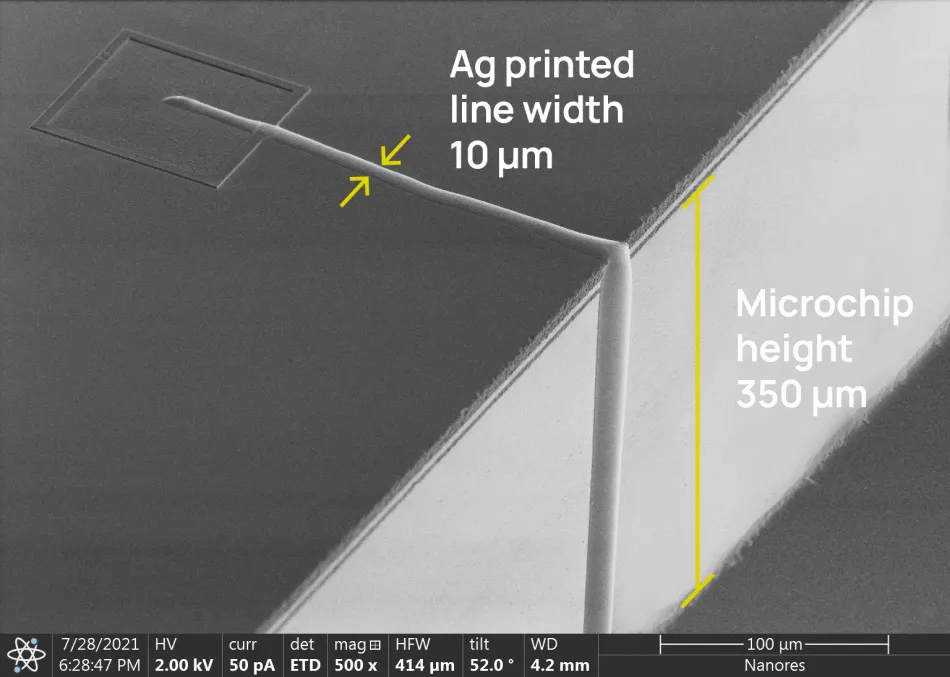Nanomaterials in 3D Electronics Printing: Enabling Multi-Material Circuit Fabrication
Nanomaterials are integrated into the 3D printing process to enhance the performance of printed electronics.

Silver nanoparticles (explanatory figure)
This article was first published on
xtpl.comNanomaterials in 3D Electronics Printing: Enabling Multi-Material Circuit Fabrication
For decades creating electronics has involved drawing patterns onto silicon and flowing traces onto those patterns. The process, while efficient enough, is aimed at mass production and hasn’t been materially upgraded in recent years, pointing to the need for an improved system. The answer? Nanomaterials, especially when used in conjunction with 3D printing.
Nanomaterials (learn more about nanotechnology) are materials with structures at the nanoscale, typically between 1 and 100 nanometers. Examples include carbon nanotubes, graphene, and quantum dots. In the context of 3D electronics printing, nanomaterials play a crucial role by enhancing the functionality and performance of printed electronics, allowing for the creation of complex, multi-material circuits.
These use multiple materials, each chosen for specific functions or unique properties. This integration enhances the performance, functionality, and versatility of the circuits.
Combining different materials
Conductive materials like copper, silver, and gold form electrical pathways and interconnections. Semiconductive materials, such as silicon and gallium arsenide, are used for transistors and diodes. Insulating materials like silicon dioxide and various polymers provide electrical isolation between conductive parts. Flexible and stretchable materials, including certain polymers and elastomers, enable the creation of bendable and wearable electronics. Nanomaterials like carbon nanotubes, graphene, and quantum dots are used to enhance electrical, thermal, and mechanical properties.
Combining different materials allows for optimizing various aspects of the circuit, such as conductivity, thermal management, and mechanical strength. Specific materials are chosen for their unique properties, resulting in better performance than circuits made from a single material. Multi-material circuits also enable the creation of intricate and compact designs, supporting the development of smaller, more efficient electronic devices. This integration reduces the need for external components and connections, enhancing overall system reliability and efficiency.
The circuits are difficult to build with traditional methods and almost impossible using standard pick and place machines. Therefore 3D printing can step in to offer real improvements over current methods.
Understanding Nanomaterials
Nanomaterials, defined by their extremely small size and unique properties, can be classified into various types. Carbon-based nanomaterials, such as carbon nanotubes and graphene, metal-based nanomaterials like silver and gold nanoparticles, polymeric nanomaterials including nanocomposites, and ceramic nanomaterials such as titanium dioxide nanoparticles all fall under this category.
These materials offer exceptional electrical, thermal, and mechanical properties, making them ideal for use in 3D printing applications.
Using Nanomaterials In 3D-Printed Electronics
Nanomaterials are integrated into the 3D printing process to enhance the performance of printed electronics. They improve electrical conductivity and thermal management, allow the creation of flexible and stretchable electronic components, and enable the miniaturization of electronic devices while maintaining high performance. These advancements make it possible to produce more efficient and compact electronic devices, expanding the potential applications of 3D printed electronics.
Using nanomaterials in 3D printing is the next step. By laying out these materials using 3D printing technology you ensure that they are correctly placed and won’t break or crack during manufacturing. For example, by extruding and placing carbon nanotubes you can print flexible sensors for wearable electronics. Silver nanoparticles can replace standard traces for circuit boards and graphene is used to print components for batteries and supercapacitors. All of these materials can be placed using 3D printing tech and benefits include improved performance, reduced material usage, and the ability to create complex geometries.
However, challenges such as material cost and processing difficulties must also be addressed. This is not inexpensive technology and without assessing the costs versus the benefits there is no sane way to inject it into a mass production process without more research.
Process Involved in Creating 3D Printed Electronics with Nanomaterials
Creating 3D printed electronics with nanomaterials involves several steps. The process begins with selecting the appropriate nanomaterial based on the desired properties, followed by developing a printable ink that contains the nanomaterial. The next step involves using a 3D printer to deposit the ink layer by layer to build the electronic component. Finally, post-processing techniques like curing or sintering are used to achieve the final properties.
Different types of nanomaterials can be used for various applications; for example, carbon nanotubes may be used for flexible electronics, while silver nanoparticles are ideal for conductive traces.
The Future of Nanomaterials
Hybrid processes combine traditional materials with nanomaterials to leverage the benefits of both, offering enhanced material properties and performance, increased design flexibility, and improved manufacturing efficiency. Compared to traditional methods, hybrid methods often provide superior performance and new functionalities, though they may introduce additional complexity and cost.
The field of 3D printed electronics with nanomaterials is evolving rapidly, with several future trends on the horizon. Advancements in nanomaterial synthesis are developing new materials with enhanced properties, while integration with emerging technologies like AI and IoT is becoming more common. Efforts are also being made to improve scalability and reduce costs, making these processes more affordable and accessible for widespread use. These trends have the potential to revolutionize electronic fabrication, making it more efficient and versatile.
Conclusion
Nanomaterials play a vital role in modern 3D electronics printing, enabling the creation of advanced, multi-material circuits. Their unique properties enhance the performance and functionality of printed electronics, paving the way for innovative applications and technologies. As the field continues to evolve, the integration of nanomaterials in electronic fabrication will become increasingly significant, driving progress and innovation in the industry. While we might not quite be at the point where 3D printing can replace traditional manufacturing, it’s definitely on the horizon and definitely something to watch.



